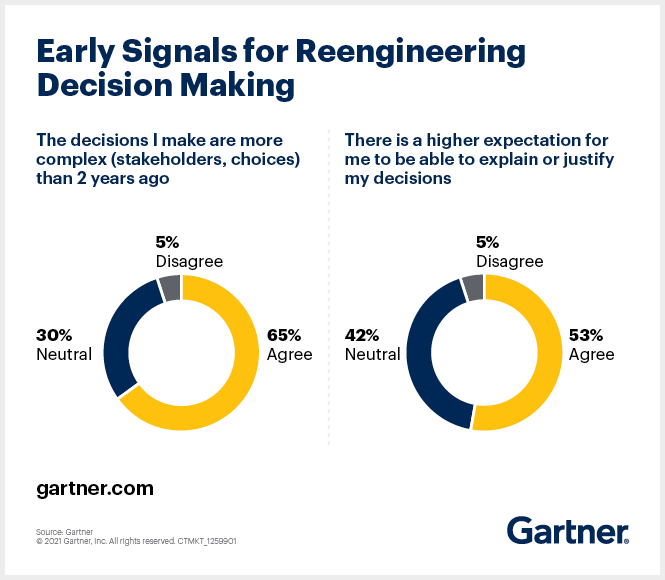“We would be able to make a much better decision on this if only we had data on that.” If you have heard that lately, you are not alone. In 2021, that missing data might be on vaccines. In 2020, it was likely data related to COVID-19 and its effects.
But those are just highly visible examples of what senior executives have struggled with for years: Too many business decisions rely heavily on data and analytical models designed for the status quo. When the context changes, decision making cannot keep up.
Download eBook: 5 Key Actions for IT Leaders to Make Better Decisions
We still make decisions as we did decades ago. Things need to change.
Rethink the role of data and analytics in effective decision making
For every organisation, decision making is a core undertaking that is becoming more complex. Decision making involves much broader considerations — their potential impacts extend across enterprises — and the lines between strategic, tactical and operational decisions are blurring.
Effective decision making requires business leaders to reframe what is essential, who or what is involved — and rethink how to leverage data and analytics to improve decision making. The result will be a new core competency, driving better business outcomes.
Critically, this is not about re-engineering every decision; it is about applying this re-engineered thought process to the most important and impactful decisions — those that cannot be made effectively with traditional approaches.
Consider what kind of data you need, what data you could exploit, what pieces of the decision making are best left to humans and what should be handled by machines. And determine the collaborations that are critical, rather than what you can manage.
Read more: How DataOps Amplifies Data and Analytics Business Value
What effective decision making looks like
In a recent survey, Gartner found that 65% of decisions made are more complex (involving more stakeholders or choices) than they were two years ago. The current state of decision making is unsustainable.
To re-engineer decisions in a way that deals with higher complexity and uncertainty, good decision making is more connected, contextual and continuous.
Connected
No decision stands on its own. Decisions by one actor affect other actors in the enterprise and ecosystem, and vice versa. Decision making needs to become much more connected, on all levels — not only hierarchically (strategic > tactical > operational), but also in a networked sense. Sharing of data and insights across organisational boundaries is critical.
Contextual
Decision alternatives need to be evaluated in a context-sensitive manner, beyond the scope of the individual event or transaction. Organisations often neglect to give their own business data and analytics the same personalisation that they know a consumer would expect.
Continuous
Organisations must be as responsive as possible to opportunities and disruptions. Decision making is becoming a much more continuous process in which organisations need to keep their options open.
Effective decision making — that is connected, contextual and continuous — results in a host of business benefits, including greater transparency, accuracy, scalability and speed.



